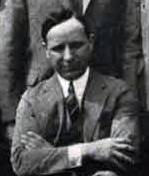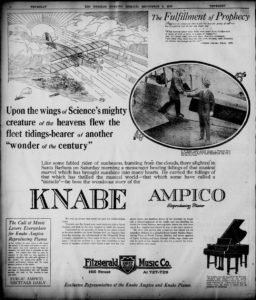
John E. Yuncker
circa 1923
One of my great-granduncles, John Ernest Yuncker (1881-1962), was my paternal great-grandmother’s younger brother. He is mentioned in his mother’s 1921 obituary as living in Los Angeles, California. I had found him listed in the California death index years ago, but I never traced him further. I recently did so and I found that he made quite a name for himself and even had a brush with history.
It turns out he was a piano salesman.1 He rose in the ranks to become an officer of the Fitzgerald Music Company in Los Angeles when it was incorporated in 1919. He eventually left Fitzgerald and formed his own company, the J. E. Yuncker Music Company. Who would think his life would be detailed over the years in music industry trade magazines? I found him mentioned several times in various issues of The Music Trade Review and Presto: The American Music Trade Weekly.
One search revealed Mr. Yuncker flew to Santa Barbara for a sales prospect because there was a railroad strike. Uninteresting I thought, until I read the article. It is dated September 20, 1919. That moves the idea of a flight to Santa Barbara from the mundane to the realm of pioneer aviation.
Actually, his flight was among the first-ever commercial passenger flights. It was aboard a two-seat open-cockpit Curtiss JN-4 “Jenny” biplane, which was likely a government surplus airplane from March Field in Riverside, California.2 In addition, it was operated by the Syd Chaplin Aircraft Corporation. Sydney Chaplin was Charlie Chaplin’s half-brother. Chaplin’s company had the first passenger service, which started on July 4, 1919, mainly flying sea planes between Los Angeles and Santa Catalina Island.3
Mr. Yuncker’s flight was Saturday, August 30, 1919. This was a couple months after Chaplin’s first passenger flight, and a few months before Chaplin’s company would cease operation in 1920. It was indeed a publicity stunt. As vice-president of sales for Fitzgerald Music, he undoubtedly made the flight to capitalize on the public fascination with airplanes. A photographer was at hand and Fitzgerald Music later used the flight in full-page advertisements. Mr. Yuncker closed a $3,300 deal, which in today’s dollars is worth about $45,000.
In this picture before the trip, the men from left to right are Harry C. Braden, General Manager, John E. Yuncker, Sales Manager, B. Traub, and the pilot, Lt. Vance.4
Here Harry C. Braden greets John E. Yuncker upon his return from Santa Barbara. A few years later in 1926 Mr. Braden would die unexpectedly while still a young man in his 30’s. Mr. Yuncker was appointed to succeed him as vice-president and treasurer of Fitzgerald Music, in addition to his duties as General Sales Manager.
A grandiose full-page advertisement did appear in the Los Angeles Evening Post on September 4, 1919. Here the “return” photo was promoted as a “send-off” photo. It mentions the trip happened “Saturday morning,” which would have been August 30.5
Here is the full text of the article from The Music Trade Review.6
TRAVELS 200 MILES IN AIR TO CLOSE AMPICO SALE
John E. Yuncker, Sales Manager of Fitzgerald Music Co., Los Angeles, Uses Airplane to Call on and Sell Prospect in Santa Barbara During Recent Railroad Strike
LOS ANGELES, CAL., September 12.—New uses for the airplane in the business world are constantly being found, but it is believed that John E Yuncker, sales manager of the Fitzgerald Music Co., this city, is the first piano man to use the airplane for carrying him to a prospect in order to close a sale. Incidentally Mr. Yuncker’s progressiveness won for him a signed order for a $3,300 Knabe Ampico reproducing piano.
During the recent railroad strike Mr. Yuncker received a request from Frank Tuhten, a wealthy real estate operator from Santa Barbara, for some details regarding the Knabe Ampico. Faced with the uncertainty of train service and the necessity of taking as little time as possible from his work at headquarters here Mr.Yuncker conceived the idea of traveling by airplane, with the result that he was in Santa Barbara and talking to the prospect before the first train had left Los Angeles.
The distance between Los Angeles and Santa Barbara in an airline is about 100 miles, yet Mr. Yuncker made the round trip and sold a piano in each city before noon. The successful carrying out of the project was due to the enterprise and ingenuity of H. C. Braden, vice-president and genera! manager of the Fitzgerald Music Co.
Not only did the unusual stunt serve to bring in the order for the Knabe Ampico, but it offered the Fitzgerald Music Co. the opportunity for some unusually striking publicity, of which full advantage was taken. Full-page advertisements were run in the local papers, showing pictures of Mr. Yuncker about to start on his unique trip and calling attention to the importance of the occasion through the medium of well-conceived text.
Mr. Yuncker made his flight at a pivotal moment in history during a brief window when the Chaplin Aircraft Corporation was in existence. The automobile was relatively new and air travel was a curiosity. There was no television, and radio was not yet widely adopted. Musical instruments were a common form of entertainment and reproducing pianos especially, were probably the best means of enjoying music short of attending a live performance. His flight was dangerous as there were frequent crashes. There were no government regulations for passenger service nor even flight insurance. The following week, the editors of The Music Trade Review summarized the importance of Mr. Yuncker’s trip to the music industry in an editorial.7
Airplanes and Pianos
The feat of John E. Yuncker, of Los Angeles, in flying by airplane to Santa Barbara, closing a sale for a reproducing piano and then returning to Los Angeles to close another sale, all in one morning, opens up new opportunities for piano merchants who have felt that their fields of activity have been limited.
Some years ago the automobile, with a special body or a trailer, took the place of the old horse-drawn wagon in handling the rural trade and enabling the piano merchant to not only cover a wider territory, but to cover it with more rapidity and more economically. Now comes the airplane and, although it may be a long time before we can even imagine an airplane as being an accepted part of the equipment of the up-to-date piano store, the fact that the airplane has been used successfully in handling a piano sale proves the piano merchants as a type are not asleep to new developments in the matter of travel that will enable them to expand their business.
John seems to have been the only one of Jacob and Margaret (Pohl) Yuncker’s many children to leave their rural farming community in Michigan to make his way west. He ended up in Los Angeles as a successful businessman. It’s not known whether he ever came home again, but I suspect his siblings knew of his success as a salesman and business owner.
Footnotes- “‘It Can Be Done’ as Trade Slogan: Fitzgerald Music Company, of Los Angeles, Proves that Summer Months May Be the Greatest of the Whole Year,” Presto: The American Music Trade Weekly, August 25, 1923; online archives, The International Arcade Museum (http://presto.arcade-museum.com/PRESTO-1923-1935/ : downloaded 11 March 2015), page 6.
- The airplane appears to be a “Jenny,” although the new Curtiss “Oriole” was also slated for service. “Syd Chaplin’s Fleet of Flyers,” Los Angeles Evening Herald, June 23, 1919, Section 2.
- Lisa K. Stein, Syd Chaplin: A Biography, (McFarland, 2010), pages 84-89.
- The same photograph appears in another trade journal. That article identifies the gentlemen pictured. “Piano Salesman Makes ‘Plane Trip to Call on a Good Prospect,” The Music Trades, Sep 20, 1919; online archives, Google Books (https://books.google.com/books?id=lptQAAAAYAAJ : downloaded 5 August 2016); Volume 58, 20 September 1919, Page 6.
- Los Angeles Evening Herald, Number 263, September 4, 1919; online archives, California Digital Newspaper Collection (http://cdna.ucr.edu : downloaded 29 June 2016), page 6.
- “Travels 200 Miles in Air to Close Ampico Sale,” The Music Trade Review, September 20, 1919; online archives, The International Arcade Museum (http://mtr.arcade-museum.com/MTR-1919-69-12/ : downloaded 11 March 2015), page 5.
- “Airplanes and Pianos,” The Music Trade Review, September 27, 1919; online archives, The International Arcade Museum (http://mtr.arcade-museum.com/MTR-1919-69-13/ : downloaded 11 March 2015), page 22.







I updated this post with the exact date of the flight, which was Saturday, August 30, 1919. I also included an image of a newly-found, full-page newspaper advertisement.